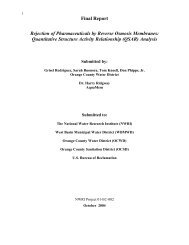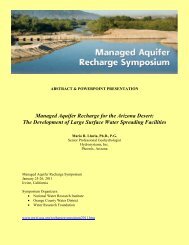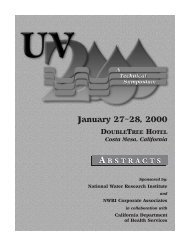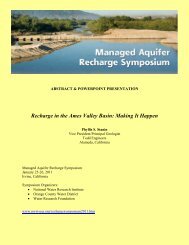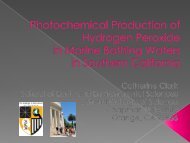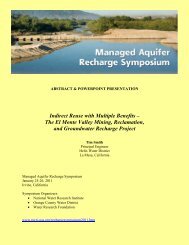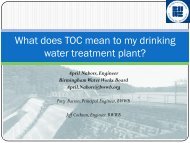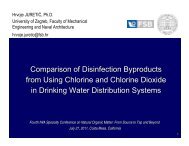Direct potable Reuse: The next frontier
Direct potable Reuse: The next frontier
Direct potable Reuse: The next frontier
Create successful ePaper yourself
Turn your PDF publications into a flip-book with our unique Google optimized e-Paper software.
<strong>Direct</strong> <strong>potable</strong> <strong>Reuse</strong>:<br />
<strong>The</strong> <strong>next</strong> <strong>frontier</strong><br />
WORKSHOP ON CRITERIA FOR<br />
DIRECT POTABLE REUSE<br />
Los Angeles, CA<br />
August 29, 2012<br />
George Tchobanoglous<br />
Department of Civil and Environmental Engineering<br />
University of California, Davis<br />
Overview of Presentation<br />
• Take Home Message<br />
• How to Think About Wastewater<br />
• Definition of Indirect and <strong>Direct</strong> Potable <strong>Reuse</strong><br />
• Driving Forces for <strong>Direct</strong> Potable <strong>Reuse</strong><br />
• Definition of <strong>Direct</strong> Potable <strong>Reuse</strong><br />
• <strong>The</strong> Future: <strong>The</strong> Southern California Example<br />
• Challenges and Opportunities for<br />
Wastewater Treatment and Water Purification<br />
1
Take Home Message<br />
Ultimately, if a significant amount of<br />
wastewater is to be recycled from large<br />
(coastal) cities, direct (and indirect)<br />
<strong>potable</strong> reuse is inevitable in urban areas<br />
and will represent an essential element of<br />
sustainable water resources management.<br />
• Must think of wastewater differently.<br />
• To make it a reality, bold new planning<br />
must begin now!!<br />
How to Think About Wastewater<br />
in the 21 st Century<br />
W t t i bl<br />
Wastewater is a renewable<br />
recoverable source of energy,<br />
nutrients, and <strong>potable</strong> water<br />
2
Driving Forces for <strong>Direct</strong> Potable <strong>Reuse</strong><br />
• <strong>The</strong> value of water will increase significantly in the<br />
future (and dramatically in some locations)<br />
• Impact of global trends: urbanization and population<br />
p<br />
demographics<br />
• De facto indirect <strong>potable</strong> reuse is largely<br />
unregulated (e.g., secondary effluent, ag runoff,<br />
urban stormwater, highway runoff)<br />
• Existing and new technologies can and will meet the<br />
water quality challenge<br />
• Population growth and global warming will lead to<br />
severe water shortages in many locations. A<br />
reliable alternative supply should be developed<br />
• Stringent environmental regulations<br />
Impact of Urbanization on Agriculture <strong>Reuse</strong><br />
3
Population Demographics:<br />
Urbanization Along Coastal Areas<br />
• By 2030, 60 percent of world’s population<br />
p<br />
will near a coastal region<br />
• Withdrawing water from inland areas,<br />
transporting it to urban population centers,<br />
treating it, using using it once, and<br />
discharging it to the coastal waters is<br />
unsustainable.<br />
Impact of Coastal Population Demographics<br />
on Water <strong>Reuse</strong><br />
4
Definition of<br />
<strong>Direct</strong> and Indirect<br />
Potable <strong>Reuse</strong><br />
Proven and Conceptual<br />
Engineered Buffer Systems<br />
5
Opportunities for the Future:<br />
<strong>The</strong> Southern California Example<br />
Water Use By County in Southern CA<br />
Quantity, Mgal/d<br />
Item<br />
Los<br />
Angeles<br />
Orange<br />
San<br />
Diego<br />
Riverside<br />
San<br />
Bernardino<br />
Population,<br />
1000’s<br />
9,935 2988 2933 1946 1964<br />
Groundwater 331 49 75 86 77<br />
Surface water 1529 335 356 349 287<br />
Total 1860 384 431 435 364<br />
6
Electric Power Consumption<br />
in Typical Urban Water Systems<br />
System<br />
Power consumption, kWh/Mgal<br />
Northern<br />
California<br />
Southern<br />
California<br />
Supply and<br />
conveyance<br />
150 8,900<br />
Water treatment 100 100<br />
Distribution 1200 1200<br />
Wastewater treatment 2,500 2,500<br />
TOTAL 3,950 12,700<br />
Opportunities for the Future:<br />
<strong>The</strong> Southern California Example<br />
7
Wastewater Management Infrastructure -<br />
Potential Locations for Water Plants<br />
Benefits of the Southern California Example<br />
• Reliable alternative source of supply, more secure<br />
from natural disasters<br />
• Lower cost and reduced energy usage<br />
• 30 billion for Bay-Delta tunnels versus 5 billion for<br />
purification treatment<br />
• More water available for agricultural use, especially<br />
during drought periods<br />
• Environmental benefits for bay delta habitat<br />
restoration<br />
8
Challenges and Opportunities for<br />
Wastewater Treatment and Water Purification<br />
• Source Control (Batch or Continuous, Response)<br />
• Energy Recovery<br />
• Modification of Raw Wastewater Characteristics<br />
• Elimination of Untreated Return Flows<br />
• Flow Equalization<br />
• Operational Mode for Biological Treatment<br />
• Improved Design and Monitoring<br />
• Ongoing Pilot Testing<br />
• Ongoing Management (24 hours per day)<br />
• New Treatment Process Flow Diagrams<br />
Energy Content of Wastewater<br />
Heat energy<br />
Specific heat of water = 4.1816 J/g •°C at 20°C<br />
Chemical oxygen demand (COD)<br />
C 5 H 7 NO 2 + 5O 2 5CO 2 + NH 3 + 2H 2 O<br />
(113) 5(32)<br />
Chemical energy (Channiwala,1992)<br />
HHV (MJ/kg) = 34.91 C + 117.83 H - 10.34 O<br />
- 1.51 N + 10.05 S - 2.11A<br />
9
Energy Content of Wastewater<br />
Constituent Unit Value<br />
Wastewater, heat basis MJ/10°C•10 3<br />
m 3 41,900<br />
Wastewater, COD basis MJ/kg COD 12 - 15<br />
Primary sludge, dry MJ/kg TSS 15 - 15.9<br />
Secondary biosolids, dry MJ/kg TSS 12.4 - 13.5<br />
Required and Available Energy for<br />
Wastewater Treatment, Exclusive of Heat Energy<br />
• Energy required for secondary wastewater<br />
treatment<br />
1,200 to 2,400 MJ/1000 m 3<br />
Energy available in wastewater for treatment<br />
(assume COD = 5.0 g/m 3 )<br />
Q = [500kg COD/1000 m 3 ) (1000 m 3 ) (13 MJ/ kg COD)<br />
6,000 MJ/1000 m 3<br />
• Energy available in wastewater is 2 to 4 times<br />
the amount required for treatment<br />
10
Alternative Technologies for<br />
Primary Treatment and Energy Recovery<br />
Impact of Recycle Flows on<br />
Nitrogen Removal<br />
Return<br />
flows<br />
contain<br />
nitrogen<br />
11
New Biological Treatment Processes<br />
Ambient Temperature Anammox Process<br />
Treatment Process Flow Diagram<br />
Pure Cycle Corporation (c.a. late 1970s)<br />
12
Conceptual Future WWTP Schematic<br />
Energy and product recovery<br />
Solids processing<br />
Preliminary treatment<br />
Primary Effluent treatment<br />
Must Develop New Treatment Process<br />
Flow Diagrams to Avoid Incremenatism<br />
13
Closing Thoughts<br />
• Technology is now available to produce water for<br />
direct <strong>potable</strong> reuse<br />
• Must resolve disconnect between existing<br />
standards and regulations and scientific findings<br />
• In promoting direct <strong>potable</strong> reuse, the profession<br />
must speak with a unified vocabulary<br />
• In the future, direct and indirect <strong>potable</strong> reuse<br />
will be a critical element in the development of<br />
sustainable strategies for water resources<br />
management<br />
THANK YOU<br />
THANK YOU<br />
FOR LISTENING<br />
14



